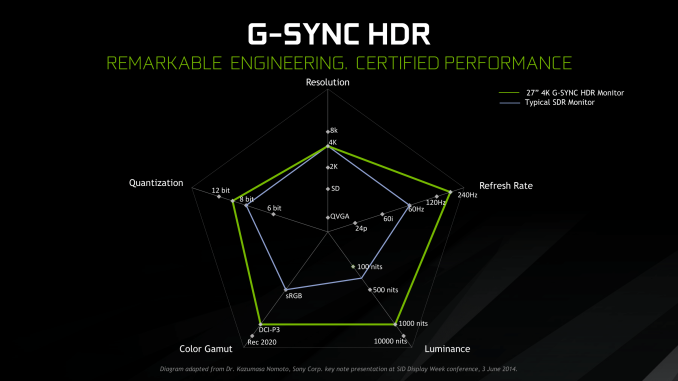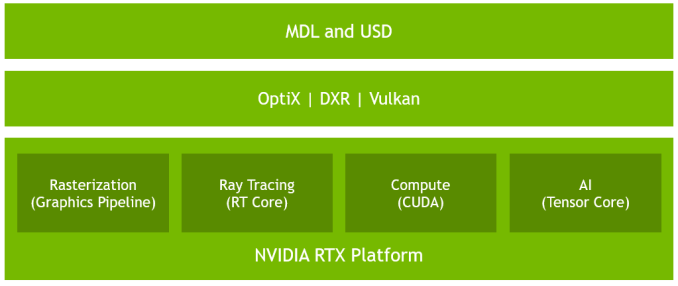The NVIDIA GeForce RTX 2080 Ti & RTX 2080 Founders Edition Review: Foundations For A Ray Traced Future
by Nate Oh on September 19, 2018 5:15 PM EST- Posted in
- GPUs
- Raytrace
- GeForce
- NVIDIA
- DirectX Raytracing
- Turing
- GeForce RTX
Meet The New Future of Gaming: Different Than The Old One
Up until last month, NVIDIA had been pushing a different, more conventional future for gaming and video cards, perhaps best exemplified by their recent launch of 27-in 4K G-Sync HDR monitors, courtesy of Asus and Acer. The specifications and display represented – and still represents – the aspired capabilities of PC gaming graphics: 4K resolution, 144 Hz refresh rate with G-Sync variable refresh, and high-quality HDR. The future was maxing out graphics settings on a game with high visual fidelity, enabling HDR, and rendering at 4K with triple-digit average framerate on a large screen. That target was not achievable by current performance, at least, certainly not by single-GPU cards. In the past, multi-GPU configurations were a stronger option provided that stuttering was not an issue, but recent years have seen both AMD and NVIDIA take a step back from CrossFireX and SLI, respectively.
Particularly with HDR, NVIDIA expressed a qualitative rather than quantitative enhancement in the gaming experience. Faster framerates and higher resolutions were more known quantities, easily demoed and with more intuitive benefits – though in the past there was the perception of 30fps as cinematic, and currently 1080p still remains stubbornly popular – where higher resolution means more possibility for details, higher even framerates meant smoother gameplay and video. Variable refresh rate technology soon followed, resolving the screen-tearing/V-Sync input lag dilemma, though again it took time to catch on to where it is now – nigh mandatory for a higher-end gaming monitor.
For gaming displays, HDR was substantively different than adding graphical details or allowing smoother gameplay and playback, because it meant a new dimension of ‘more possible colors’ and ‘brighter whites and darker blacks’ to gaming. Because HDR capability required support from the entire graphical chain, as well as high-quality HDR monitor and content to fully take advantage, it was harder to showcase. Added to the other aspects of high-end gaming graphics and pending the further development of VR, this was the future on the horizon for GPUs.
But today NVIDIA is switching gears, going to the fundamental way computer graphics are modelled in games today. Of the more realistic rendering processes, light can be emulated as rays that emit from their respective sources, but computing even a subset of the number of rays and their interactions (reflection, refraction, etc.) in a bounded space is so intensive that real time rendering was impossible. But to get the performance needed to render in real time, rasterization essentially boils down 3D objects as 2D representations to simplify the computations, significantly faking the behavior of light.
It’s on real time ray tracing that NVIDIA is staking its claim with GeForce RTX and Turing’s RT Cores. Covered more in-depth in our architecture article, NVIDIA’s real time ray tracing implementation takes all the shortcuts it can get, incorporating select real time ray tracing effects with significant denoising but keeping rasterization for everything else. Unfortunately, this hybrid rendering isn’t orthogonal to the previous concepts. Now, the ultimate experience would be hybrid rendered 4K with HDR support at high, steady, and variable framerates, though GPUs didn’t have enough performance to get to that point under traditional rasterization.
There’s a still a performance cost incurred with real time ray tracing effects, except right now only NVIDIA and developers have a clear idea of what it is. What we can say is that utilizing real time ray tracing effects in games may require sacrificing some or all three of high resolution, ultra high framerates, and HDR. HDR is limited by game support more than anything else. But the first two have arguably minimum performance standards when it comes to modern high-end gaming on PC – anything under 1080p is completely unpalatable, and anything under 30fps or more realistically 45 to 60fps hurts the playability. Variable refresh rate can mitigate the latter and framedrops are temporary, but low resolution is forever.
Ultimately, the real time ray tracing support needs to be implemented by developers via a supporting API like DXR – and many have been working hard on doing so – but currently there is no public timeline of application support for real time ray tracing, Tensor Core accelerated AI features, and Turing advanced shading. The list of games with support for Turing features - collectively called the RTX platform - will be available and updated on NVIDIA's site.













337 Comments
View All Comments
Billstpor - Friday, September 21, 2018 - link
Wrong. It's already known that the tensor cores have enough juice to run ray-traced effects and DLSS at the same time:https://youtu.be/pgEI4tzh0dc?t=10m55s
Vayra - Monday, September 24, 2018 - link
Wrong, the tensor cores need DLSS to run ray tracing at somewhat bearable FPS - that is, 30 to 60.DLSS is a way to reduce the amount of rays to cast.
Vayra - Monday, September 24, 2018 - link
Hence the non-existant improvement, or even worse position in terms of quality compared to SSAA x4 or better.In other words, running at native 4K is miles sharper and will perform miles better than a DLSS+RTRT combination still.
IUU - Sunday, September 23, 2018 - link
While your argument is solid, these days are just so weird that even $1200 cards seem to make a hell of a lot sense. This is also valid for similar desktop cpus.Why? Well , go buy a high-end iphone or a high end android phone... Enough said.
PS. For those who may use arguments like geekbench and such , it is just insulting to put it very very kindly!
Gastec - Thursday, September 27, 2018 - link
So basically buying high-priced electronics make sense because the companies selling them just increase the prices every year to make profits and a certain type of consumers are supporting those companies by purchasing no matter what the price (call them fanbois). The question is: Why, why are those people acting like that? What drives them?watek - Wednesday, September 19, 2018 - link
Consumers paying these premium prices for features that are not even fully developed or finished is mind boggling!! People are being bent over and screwed by Nvidia hard yet they still pay $1500 to be beta testers until next Gen.V900 - Wednesday, September 19, 2018 - link
Mindboggling? I suppose it would be for a time traveller visiting from the 19th century, but for everyone else it’s perfectly normal.There is always a price premium for those early adopters who want to live on the cutting edge of technology.
When DVD players came out, they cost over a 1000$ and the selection of movies they could watch was extremely small. When Blu-ray players came out, they also cost well over 1000$ and the entire catalogue of Blu-ray titles was a dozen movies or so.
And keep in mind, that the price that Nvidia charges for joining the early adopter club is really shockingly low.
When OLED or 4K televisions first came out, people paid tens of thousands of dollars for a set, and the selection of 4K entertainment to watch on them was pretty much zero.
With the 2080, early adopters can climb aboard for 600-1000$.
Games that take advantage of DLSS and RTX will be here soon and in the meantime they have the most powerful graphics card on the market that will play pretty much anything you can throw at it, in 4K without breaking a sweat.
It’s not a bad deal at all.
imaheadcase - Wednesday, September 19, 2018 - link
Again, two technology that have not even seen the real light of day, let alone to be proven worth it at all. Early adopters of the other techs you listed at least got WORKING TECH from the start as promised.V900 - Wednesday, September 19, 2018 - link
Ok, you’re either deliberately spreading untruths and FUD, or you just haven’t paid attention.There are games NOW that support RTX and DLSS. Games like Shadow of the Tombraidet, Control and PUBG.
And there are more games coming out THIS YEAR with RTX/DLSS support: Battlefield 5 is one of them.
The next Metro is one of many games coming out in early 2019 that also support RTX.
So tell me again how this is different from when Blueray players came out?
imaheadcase - Wednesday, September 19, 2018 - link
THose games you listed don't have it now, they are COMING. lol Even then the difference is not even worth it considering the games don't hardly take a hit for the 1080TI. You are the nvidia shill on here and forums as everyone knows.